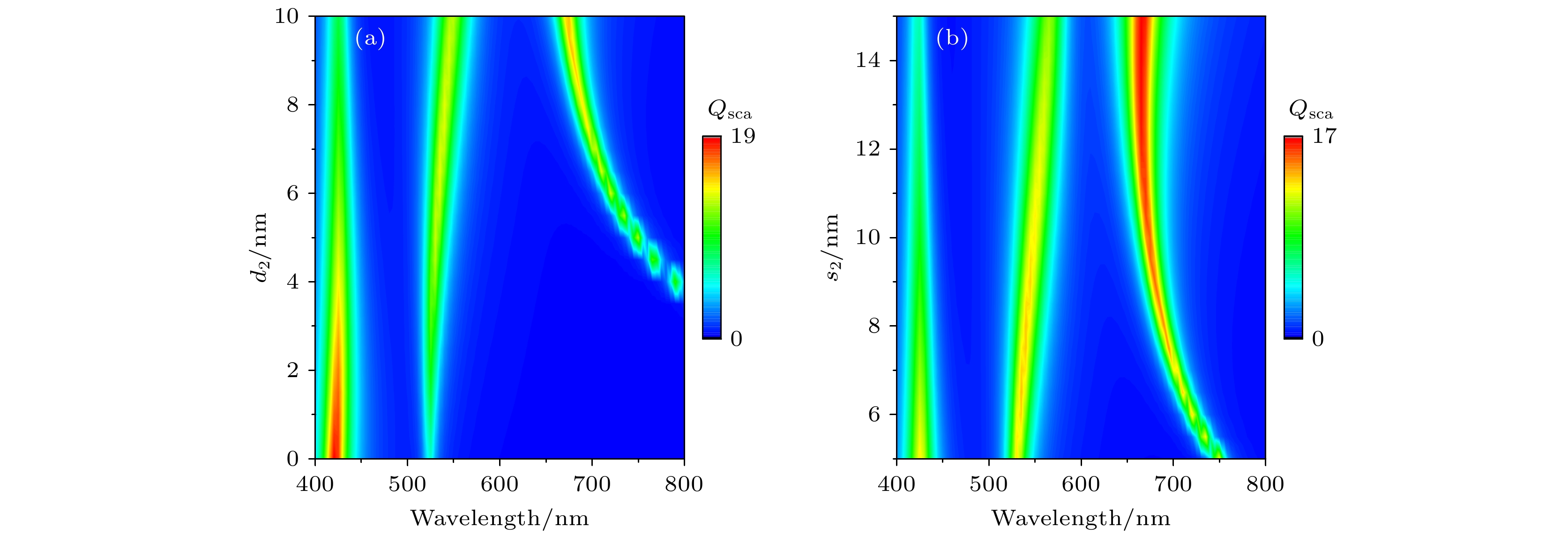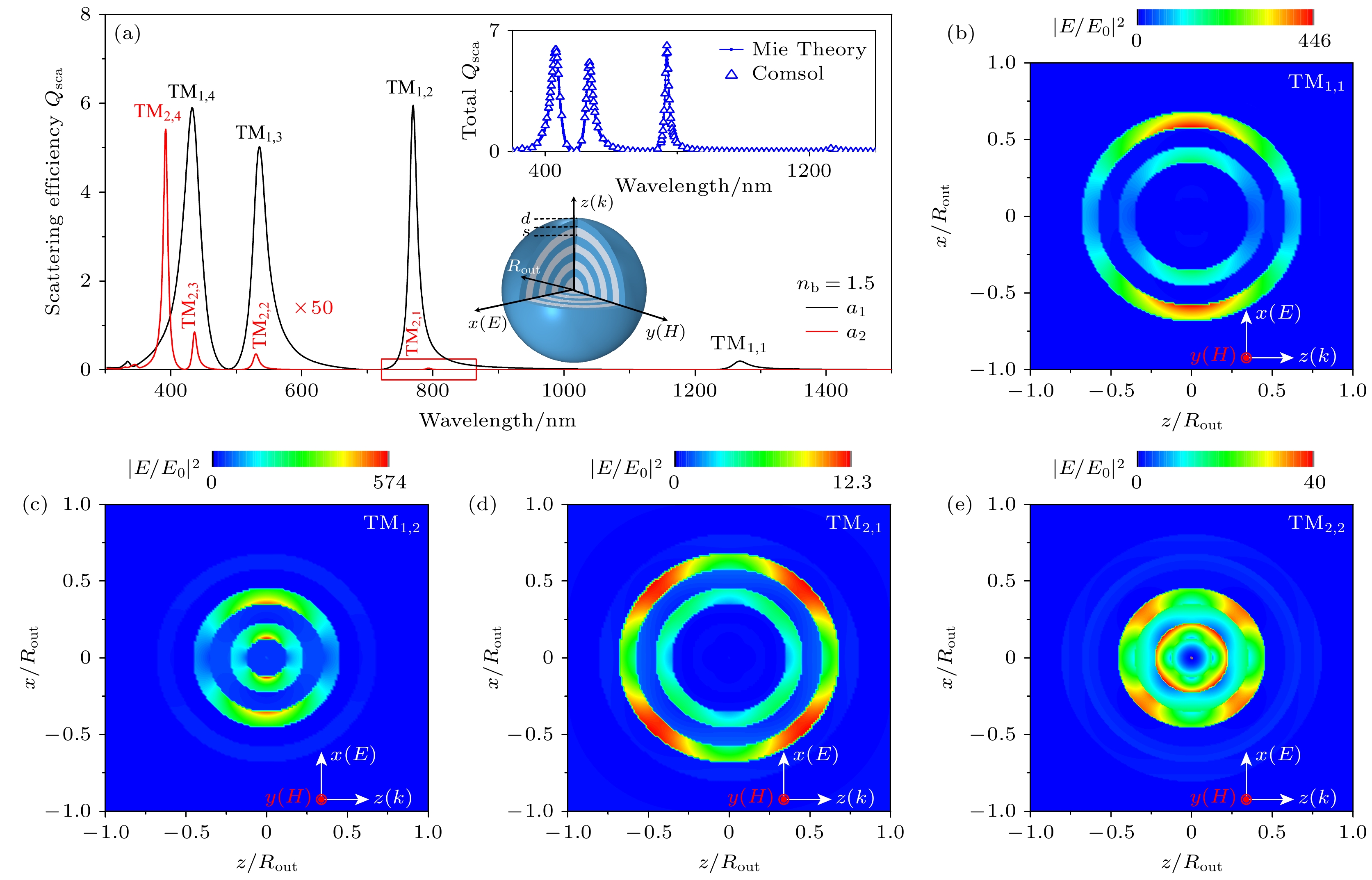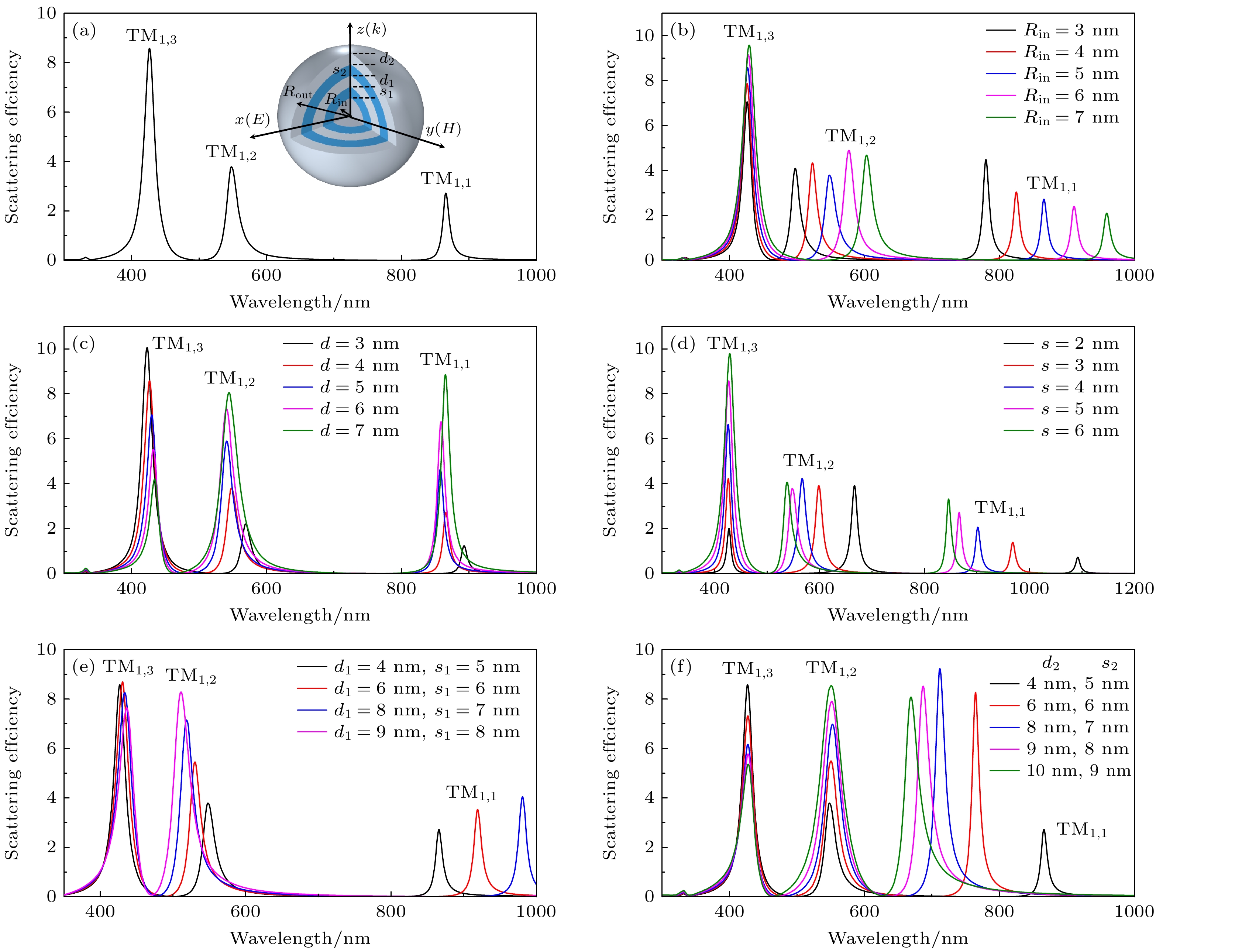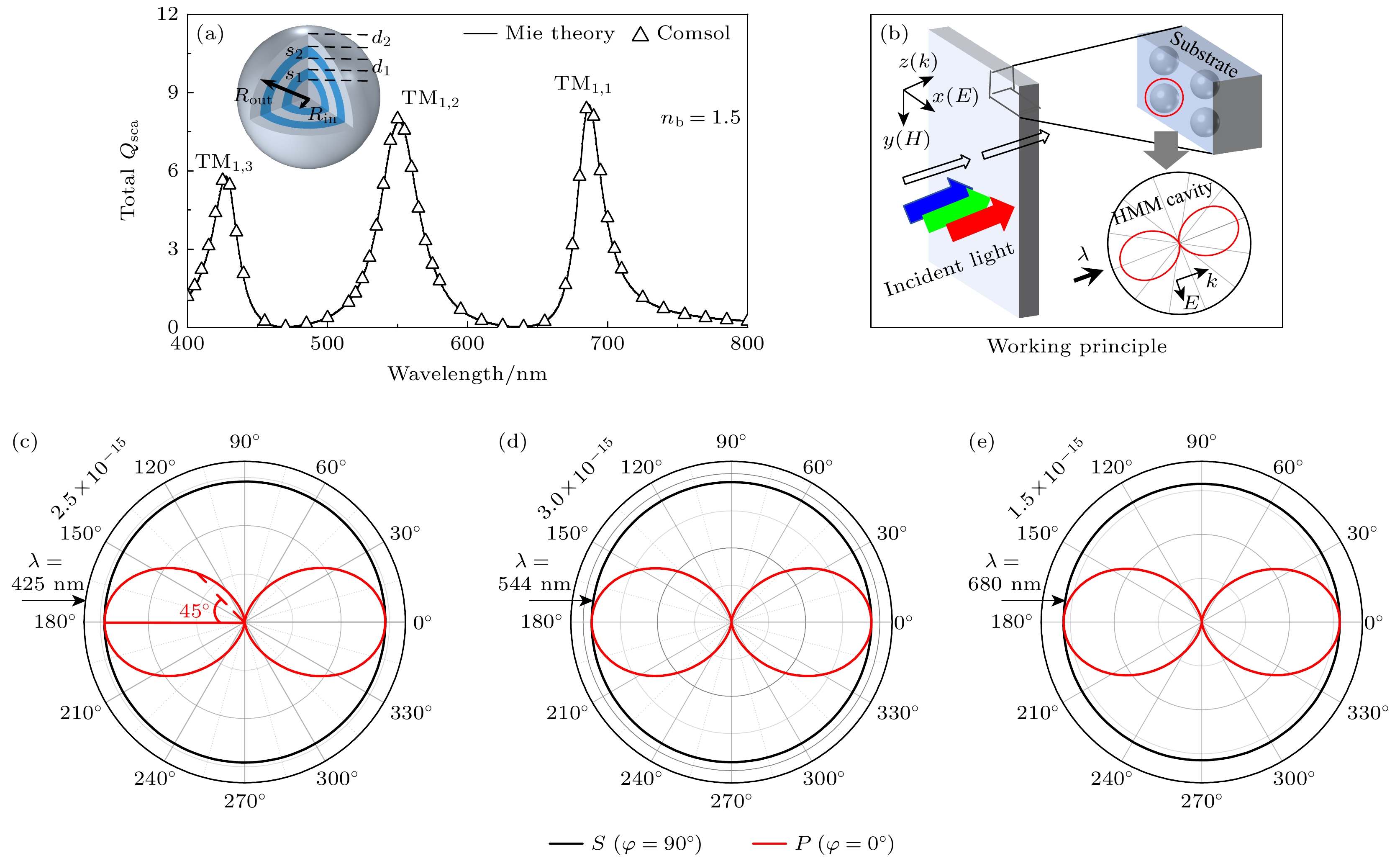-
本文提出并设计了一种用于提高彩色透明显示性能的球形双曲色散超材料(HMM)腔. 该腔由介质/银层交替包裹银核组成, 具有深度亚波长性质, 并支持和银层数目相同的同阶回音廊模式. 这些模式能够将电磁波能量高度局域在不同介质壳层内, 从而降低欧姆损耗, 减小共振线宽. 针对5层银/介质交替包裹形成的HMM腔, 详细分析了结构参数对回音廊模式的调谐作用. 发现仅改变最外层介质或银层厚度, 几乎不影响TM1,2和TM1,3模式的共振位置, 但对TM1,1模式的共振位置及3个模式的强度产生明显调谐. 通过优化HMM腔, 在红绿蓝波段实现三重窄带共振, 且在三重共振位置均具有偶极辐射特点, 能够将散射光限制在和入射光夹角为–45°—+45°范围内. 该HMM腔不仅支持红绿蓝三重窄带共振, 并具有宽的散射角, 可应用于实现高透明度、高亮度和宽视角的全彩透明显示.A novel spherical hyperbolic metamaterial (HMM) cavity for enhancing color-transparent display is designed in this work. This HMM cavity consists of a silver core wrapped alternatively by several dielectric layers and silver layers. According to the effective medium theory and Mie scattering theory, we demonstrate that such an HMM cavity supports multiple whispering-gallery modes with deep subwavelength characteristics. The number of whispering-gallery modes with the same angular momentum is equal to the number of silver layers within the HMM cavity. Furthermore, we demonstrate that these excited whispering-gallery modes are capable of strongly confining the electric fields within the different dielectric shell layers, thus reducing Ohmic losses and narrowing resonance linewidths. In addition, we systematically investigate how the structure parameters affect whispering-gallery modes for an HMM cavity with 5 alternative dielectric layers and silver layers. Interestingly, by increasing the thickness of outermost dielectric layer and silver layer, the resonance wavelength of TM1,2 mode and TM1,3 mode remain nearly unchanged. However, the TM1,1 mode experiences a significant blueshift, and the intensity of the TM1,1, TM1,2 and TM1,3 mode can be substantially tuned. Consequently, through structural optimization, the HMM cavity can support triple narrowband resonances in the red, green, and blue spectral regions. Finally, we show that the HMM cavity exhibits dipole radiation characteristics at the three resonance wavelengths, effectively confining light within an angular range from –45° to +45° relative to the incident light direction, and confirming the scattered light viewed from a wide angle. These features make the HMM cavity suitable for achieving high transparency, brightness, and wide viewing angles in full-color transparent displays.
-
Keywords:
- hyperbolic metamaterial cavity /
- Mie scattering /
- whispering-gallery mode /
- transparent display
[1] Hsu C W, Zhen B, Qiu W J, Shapira O, DeLacy B G, Joannopoulos J D, Soljačić M 2014 Nat. Commun. 5 3152
 Google Scholar
Google Scholar
[2] Hedili M K, Freeman M O, Urey H 2012 Proc. SPIE. 8428 84280X
 Google Scholar
Google Scholar
[3] Görrn P, Sander M, Meyer J, Kroger M, Becker E, Johannes H, Kowalsky W, Riedl T 2006 Adv. Mater. 18 738
 Google Scholar
Google Scholar
[4] Hedili M K, Freeman M O, Urey H 2013 Appl. Opt. 52 1117
 Google Scholar
Google Scholar
[5] Goldenberg J F, McKechnie T S 1985 Opt. Soc. Am. A 2 2337
 Google Scholar
Google Scholar
[6] Hedili M K, Freeman M O, Urey H 2013 Opt. Express 21 24636
 Google Scholar
Google Scholar
[7] Hong K, Yeom J, Jang C, Hong Jisoo, Lee B 2014 Opt. Lett. 39 127
 Google Scholar
Google Scholar
[8] Soomro S R, Urey H 2016 Opt. Express 24 24232
 Google Scholar
Google Scholar
[9] Kravets V G, Schedin F, Grigorenko A N 2008 Phys. Rev. Lett. 101 087403
 Google Scholar
Google Scholar
[10] 王振林 2009 物理学进展 3 287
 Google Scholar
Google Scholar
Wang Z L 2009 Phys. Pro. 3 287
 Google Scholar
Google Scholar
[11] Smith D R, Schurig D 2003 Phys. Lett. 90 077405
 Google Scholar
Google Scholar
[12] Yang X D, Yao J, Rho J, Yin X B, Zhang X 2012 Nat. Photon. 6 450
 Google Scholar
Google Scholar
[13] Saito K, Tatsuma T 2015 Nanoscale 7 20365
 Google Scholar
Google Scholar
[14] Ye Y Y, Chen T P, Zhen J Y, Xu C, Zhang J, Li H K 2018 Nanoscale 10 2438
 Google Scholar
Google Scholar
[15] Soomro S R, Urey H 2017 Appl. Opt. 56 6108
 Google Scholar
Google Scholar
[16] Shin S, Boyeon H, Zhao Z J, Jeon S H, Jung J Y, Lee J H, Ju B K, Jeonget J H 2018 Sci. Rep. 8 2463
 Google Scholar
Google Scholar
[17] Chu B, Li Y, Qin Y H, Hu T Z, Zhong F C, Zeng F G, Ding P, Shao L, Du Y X, Tian S, Chen Z 2023 Nanotechnology 34 325301
 Google Scholar
Google Scholar
[18] Barnes W L, Alain D, Ebbesen T W 2003 Nature 424 824
 Google Scholar
Google Scholar
[19] Sun J B, Shalaev M I, Litchinitser N M 2015 Nat. Commun. 6 7201
 Google Scholar
Google Scholar
[20] Wan M J, Gu P, Liu W Y, Chen Z, Wang Z L 2017 Appl. Phys. Lett. 110 031103
 Google Scholar
Google Scholar
[21] 李艳, 钟发成, 褚博, 邵立, 王俊俏, 万明杰, 杨鹏, 王妍妍, 丁佩, 曾凡光, 于占军, 许坤, 杜银霄, 霍海波, 陈卓, 王振林 2021 中国科学: 物理学 力学 天文学 51 104211
 Google Scholar
Google Scholar
Li Y, Zhong F C, Chu B, Shao L, Wang J Q, Wan M J, Yang P, Wang Y Y, Ding P, Zeng F G, Yu Z J, Xu K, Du Y X, Huo H B, Chen Z, Wang Z L 2021 Sci. Sin. Phys. Mech. As. 51 104211
 Google Scholar
Google Scholar
[22] Gu P, Chen J, Chen S Y, Yang C, Zhang Z X, Du W, Yan Z D, Tang C J, Chen Z 2021 Photonics Res. 9 829
 Google Scholar
Google Scholar
[23] Gu P, Guo Y H, Chen J, Zhang Z X, Yan Z D, Liu F X, Tang C J, Du W, Chen Z 2021 Nanomaterials 11 2301
 Google Scholar
Google Scholar
[24] Bohren C F, Huffman D R 1983 Absorption and Scattering of Light by Small Particls Optics (New York: Wiley) p475
[25] Johnson P B, Christy R W 1972 Phys. Rev. B 6 4370
 Google Scholar
Google Scholar
[26] Wu C, Salandrino A, Ni X, Zhang X 2014 Phys. Rev. X 4 021015
 Google Scholar
Google Scholar
[27] Knight M W, Halas N J 2008 New J. Phys. 10 105006
 Google Scholar
Google Scholar
[28] Fan X, Zheng W, Singh D J 2014 Light Sci. Appl. 3 179
 Google Scholar
Google Scholar
[29] Prodan E, Radloff C, Halas N J, Nordlander P 2003 Science 302 419
 Google Scholar
Google Scholar
-
图 1 (a) 由介质和银交替包裹银核组成的球形HMM腔结构示意图; (b) 由有效介质理论在f = 0.5 ×1015 Hz处计算该HMM腔的等频面 (黑色曲线), 蓝色圆代表光在空气中的等频面; (c) 4对银 (Rin = d = 5 nm)/介质层 (s = 4 nm) 交替包裹形成的HMM腔, 在角动量数n = 3的八极子共振 (波长λ = 600 nm, 频率f = 0.5 ×1015 Hz) 处的电场强度分布图
Fig. 1. (a) A schematic of the HMM cavity formed by alternately wrapping a silver core with dielectric and silver layers; (b) the hyperbolic isofrequency contour (black line) of the cavity in the momentum space calculated with the effective medium approximation at a frequency of f = 0.5×1015 Hz, the blue line represents the corresponding isofrequency contour of air; (c) electric field intensity enhancement distributions of the HMM cavity formed by 4 pairs of silver (Rin = d = 5 nm) and dielectric (s = 4 nm, nd = 1.45) layers at octupolar resonant wavelength λ = 600 nm with the angular momentum n = 3.
图 4 固定HMM腔中Rin = 5 nm, s1 = 4 nm, d1 = 5 nm, 介质折射率n1 = 1.8, n2 = 1.45情况下 (a) 同时固定s2 = 9 nm, 银壳层厚度d2从0 nm到10 nm时, HMM腔的散射效率谱; (b) 同时固定d2=8 nm, 介质层厚度s2从5 nm到15 nm时, HMM腔的散射效率谱
Fig. 4. (a) The scattering efficiency spectra as a function of the wavelength and the thinkness of the third silver layer (d2 ) for the HMM cavities with fixed Rin = 5 nm, s1 = 4 nm, d1 = 5 nm, d2 = 8 nm, s2 = 9 nm and n2 = 1.45; (b) the scattering efficiency spectra as a function of the wavelength and the thickness of the second dielectric layer (s2 ) for the HMM cavities with fixed Rin = 5 nm, s1 = 4 nm, d1 = 5 nm, d2 = 8 nm, n1 = 1.8, and n2 = 1.45.
图 2 (a) 由8层银(Rin = d = 5 nm)和介质层(s = 4 nm, nb = 1.5) 交替包裹组成的HMM腔的散射谱, 这里展示了偶极和四极电分量的贡献(a1, a2), 为了更清楚地显示电四极子的贡献, 将其散射效率值扩大了50倍, 右上方插图是通过Comsol软件模拟(蓝色三角)和米氏散射理论计算(蓝色实线)的总散射效率谱; (b) 结构在TM1,1模式共振波长λ = 1266 nm处的电场强度分布图; (c) 结构在TM1,2模式共振波长λ = 768 nm处的电场强度分布图; (d) 结构在TM2,1模式共振波长λ = 791 nm处的电场强度分布图; (e) 结构在TM2,2模式共振波长λ = 531 nm处的电场强度分布图
Fig. 2. (a) The scattering efficiency spectra (the contributions from the first two electric terms (a1, a2), respectively) of the HMM cavity (inset) formed by eight layers of silver (Rin = d = 5 nm) and dielectric (s = 4 nm). For clarity, the contribution from a2 is magnified 50 times. Top inset shows the total scattering efficiency spectra simulated based on Comsol software (blue triangle) and calculated based on Mie scattering theory (blue line), respectively. (b)—(e) Electric field intensity enhancement distributions of the two dipolar resonances (b) TM1,1 and (c) TM1,2, and two quadrupolar resonances (d) TM2,1 and (e) TM2,2, respectively.
图 3 (a) 5层银(Rin = d1 = d2 = 5 nm)/介质层(s1 = s2 = 4 nm, n1 = 1.8, n2 = 1.45)交替包裹组成的球形HMM腔的散射谱, 插图为HMM腔的结构示意图; (b) 改变HMM腔中银核尺寸Rin的散射效率谱; (c) 改变HMM腔中银层厚度(保持Rin = 5 nm, d1 = d2)的散射效率谱; (d) 改变HMM腔中介质层厚度s1 = s2的散射效率谱; (e) 分别改变HMM腔中第2层银层厚度d1和第1层介质层厚度s1的散射效率谱; (f) 分别改变HMM腔中第3层银层厚度d2和第2层介质层厚度s2的散射效率谱
Fig. 3. (a) The scattering efficiency spectrum of the HMM cavity (inset) formed by five layers of silver (Rin = d1 = d2 = 5 nm) and dielectric (s1 = s2 = 4 nm, n1 = 1.8, n2 = 1.45); (b)–(d) the scattering efficiency spectra of HMM cavities same as the structure used in (a), but with different core radii (b), different thinknesses of the silver layers (c) and different thinknesses of the dielectric layers (d); (e), (f) the scattering efficiency spectra of HMM cavities same as the structure used in (a), but with different thinknesses of the second silver layer (d1) and first dielectric layers (s1) (e) and different thinknesses of third silver layer (d2) and second dielectric layers (s2) (f).
图 5 (a) 5层银 (Rin = d1 = 5 nm, d2 = 10 nm) /介质层 (s1 = 4 nm, s2 = 9 nm, n1 = 1.8, n2 = 1.45) 交替包裹形成的球形HMM腔的散射效率谱, 黑色三角形代表用Comsol软件模拟的结果, 黑色实线为基于米氏散射理论求解析计算的结果; (b) 基于HMM腔波长选择性散射的透明显示器示意图; (c)—(e) HMM腔在偶极共振波长 (c) λ ≈ 425 nm (TM1,3), (d) λ ≈ 544 nm (TM1,2), (e) λ ≈ 680 nm (TM1,3)的二维散射角分布图. 其中红色和黑色曲线分别为散射平面处于和ϕ = 0和ϕ = π/2的情况
Fig. 5. (a) The total scattering efficiency spectra based on Comsol software (black triangle) and Mie scattering theory (black line) for the HMM cavity formed by five layers of silver (Rin = d1 = 5 nm, d2 = 10 nm) and dielectric (s1 = 4 nm. s2 = 9 nm, n1 = 1.8, n2 = 1.45); (b) a schematic for a transparent display based on HMM cavities with wavelength-selective scattering; (c)–(e) the 2D scattering angle distribution of the structure at wavelengths of (c) λ ≈ 425 nm (TM1,3), (d) λ ≈ 544 nm (TM1,2), and (e) λ ≈ 680 nm (TM1,3) at dipole resonance. Red and black curves correspond to the case of scattering plane at ϕ = 0 and ϕ = π/2, respectively.
-
[1] Hsu C W, Zhen B, Qiu W J, Shapira O, DeLacy B G, Joannopoulos J D, Soljačić M 2014 Nat. Commun. 5 3152
 Google Scholar
Google Scholar
[2] Hedili M K, Freeman M O, Urey H 2012 Proc. SPIE. 8428 84280X
 Google Scholar
Google Scholar
[3] Görrn P, Sander M, Meyer J, Kroger M, Becker E, Johannes H, Kowalsky W, Riedl T 2006 Adv. Mater. 18 738
 Google Scholar
Google Scholar
[4] Hedili M K, Freeman M O, Urey H 2013 Appl. Opt. 52 1117
 Google Scholar
Google Scholar
[5] Goldenberg J F, McKechnie T S 1985 Opt. Soc. Am. A 2 2337
 Google Scholar
Google Scholar
[6] Hedili M K, Freeman M O, Urey H 2013 Opt. Express 21 24636
 Google Scholar
Google Scholar
[7] Hong K, Yeom J, Jang C, Hong Jisoo, Lee B 2014 Opt. Lett. 39 127
 Google Scholar
Google Scholar
[8] Soomro S R, Urey H 2016 Opt. Express 24 24232
 Google Scholar
Google Scholar
[9] Kravets V G, Schedin F, Grigorenko A N 2008 Phys. Rev. Lett. 101 087403
 Google Scholar
Google Scholar
[10] 王振林 2009 物理学进展 3 287
 Google Scholar
Google Scholar
Wang Z L 2009 Phys. Pro. 3 287
 Google Scholar
Google Scholar
[11] Smith D R, Schurig D 2003 Phys. Lett. 90 077405
 Google Scholar
Google Scholar
[12] Yang X D, Yao J, Rho J, Yin X B, Zhang X 2012 Nat. Photon. 6 450
 Google Scholar
Google Scholar
[13] Saito K, Tatsuma T 2015 Nanoscale 7 20365
 Google Scholar
Google Scholar
[14] Ye Y Y, Chen T P, Zhen J Y, Xu C, Zhang J, Li H K 2018 Nanoscale 10 2438
 Google Scholar
Google Scholar
[15] Soomro S R, Urey H 2017 Appl. Opt. 56 6108
 Google Scholar
Google Scholar
[16] Shin S, Boyeon H, Zhao Z J, Jeon S H, Jung J Y, Lee J H, Ju B K, Jeonget J H 2018 Sci. Rep. 8 2463
 Google Scholar
Google Scholar
[17] Chu B, Li Y, Qin Y H, Hu T Z, Zhong F C, Zeng F G, Ding P, Shao L, Du Y X, Tian S, Chen Z 2023 Nanotechnology 34 325301
 Google Scholar
Google Scholar
[18] Barnes W L, Alain D, Ebbesen T W 2003 Nature 424 824
 Google Scholar
Google Scholar
[19] Sun J B, Shalaev M I, Litchinitser N M 2015 Nat. Commun. 6 7201
 Google Scholar
Google Scholar
[20] Wan M J, Gu P, Liu W Y, Chen Z, Wang Z L 2017 Appl. Phys. Lett. 110 031103
 Google Scholar
Google Scholar
[21] 李艳, 钟发成, 褚博, 邵立, 王俊俏, 万明杰, 杨鹏, 王妍妍, 丁佩, 曾凡光, 于占军, 许坤, 杜银霄, 霍海波, 陈卓, 王振林 2021 中国科学: 物理学 力学 天文学 51 104211
 Google Scholar
Google Scholar
Li Y, Zhong F C, Chu B, Shao L, Wang J Q, Wan M J, Yang P, Wang Y Y, Ding P, Zeng F G, Yu Z J, Xu K, Du Y X, Huo H B, Chen Z, Wang Z L 2021 Sci. Sin. Phys. Mech. As. 51 104211
 Google Scholar
Google Scholar
[22] Gu P, Chen J, Chen S Y, Yang C, Zhang Z X, Du W, Yan Z D, Tang C J, Chen Z 2021 Photonics Res. 9 829
 Google Scholar
Google Scholar
[23] Gu P, Guo Y H, Chen J, Zhang Z X, Yan Z D, Liu F X, Tang C J, Du W, Chen Z 2021 Nanomaterials 11 2301
 Google Scholar
Google Scholar
[24] Bohren C F, Huffman D R 1983 Absorption and Scattering of Light by Small Particls Optics (New York: Wiley) p475
[25] Johnson P B, Christy R W 1972 Phys. Rev. B 6 4370
 Google Scholar
Google Scholar
[26] Wu C, Salandrino A, Ni X, Zhang X 2014 Phys. Rev. X 4 021015
 Google Scholar
Google Scholar
[27] Knight M W, Halas N J 2008 New J. Phys. 10 105006
 Google Scholar
Google Scholar
[28] Fan X, Zheng W, Singh D J 2014 Light Sci. Appl. 3 179
 Google Scholar
Google Scholar
[29] Prodan E, Radloff C, Halas N J, Nordlander P 2003 Science 302 419
 Google Scholar
Google Scholar
计量
- 文章访问数: 4634
- PDF下载量: 58
- 被引次数: 0
















 下载:
下载:




